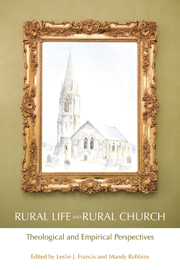Book contents
- Frontmatter
- Contents
- Preface
- Foreword by The Bishop of Shrewsbury, The Rt Revd Mark Rylands
- 1 Introduction: shaping rural theology
- PART 1 PERSPECTIVES FROM THE BIBLE
- PART 2 PERSPECTIVES FROM ORDINARY THEOLOGY
- PART 3 THEOLOGICAL AND SOCIOLOGICAL PERSPECTIVES
- PART 4 HISTORICAL PERSPECTIVES
- 11 Blackshawhead: a local case history in rural church categorization
- 12 Is the rural church different? The special case of confirmation
- 13 Rural Anglicanism: one face or many?
- 14 Pastoral fragments: discovered remnants of a rural past
- PART 5 LISTENING TO VISITORS
- PART 6 LISTENING TO THE COMMUNITY
- PART 7 LISTENING TO CHURCHGOERS
- PART 8 LISTENING TO CHURCH LEADERS
- PART 9 SATISFACTION AND STRESS IN MINISTRY
- Contributors
- Sources
- Subject Index
- Name Index
11 - Blackshawhead: a local case history in rural church categorization
from PART 4 - HISTORICAL PERSPECTIVES
- Frontmatter
- Contents
- Preface
- Foreword by The Bishop of Shrewsbury, The Rt Revd Mark Rylands
- 1 Introduction: shaping rural theology
- PART 1 PERSPECTIVES FROM THE BIBLE
- PART 2 PERSPECTIVES FROM ORDINARY THEOLOGY
- PART 3 THEOLOGICAL AND SOCIOLOGICAL PERSPECTIVES
- PART 4 HISTORICAL PERSPECTIVES
- 11 Blackshawhead: a local case history in rural church categorization
- 12 Is the rural church different? The special case of confirmation
- 13 Rural Anglicanism: one face or many?
- 14 Pastoral fragments: discovered remnants of a rural past
- PART 5 LISTENING TO VISITORS
- PART 6 LISTENING TO THE COMMUNITY
- PART 7 LISTENING TO CHURCHGOERS
- PART 8 LISTENING TO CHURCH LEADERS
- PART 9 SATISFACTION AND STRESS IN MINISTRY
- Contributors
- Sources
- Subject Index
- Name Index
Summary
Abstract – A number of studies have sought to categorize churches according to their location in situations which can be said to be rural or urban, or some mix of each of these two types of settlement patterns. Such categorization has uncertainties, and the attempts to refine systems sometimes give rise to debate about the criteria to be used, and to contradictions between the resulting scales suggested by different studies. This article seeks to question existing criteria and systems of categorization by using a local church's experience as a case history, and also to point up other issues related to small church experience in an isolated situation. It also seeks to draw attention to the value of the study of the local church for more general issues in rural theology.
What is rural?
A recent publication, Sowing the Seed by the Churches' Regional Commission for Yorkshire and the Humber (2003), describes its area of rural concern as ‘not only the vast rural tracts of North Yorkshire, the Dales and the North York Moors, but also the Wolds of the East Riding; west of Halifax to Todmorden, and north toward Keighley; south and east of Huddersfield’ and so on. In the text which follows, however, it describes Christian initiatives for neighbourhood communities only in the well cultivated and fertile parts of the region and has nothing to say about the rolling vast areas of moorland where nothing grows except rough grass and heather, and which is populated only by sheep and the occasional isolated farm.
- Type
- Chapter
- Information
- Rural Life and Rural ChurchTheological and Empirical Perspectives, pp. 120 - 130Publisher: Acumen PublishingPrint publication year: 2012



